The wolf also shall dwell with the lamb, and the leopard shall lie down with the kid; and the calf and the young lion and the fatling together; and a little child shall lead them. Isaiah 11:6
I love watching the weather move in. At its simplest, Oaxaca has two seasons, rainy and dry. This is a bit too simple given Oaxaca’s incredibly diverse geography, beach, coastal plain, rain forest, high desert, desert, mountains and fertile valleys. We are coming to the end of a strange rainy season with heavy rains every afternoon and evening. It has been dry in many areas and every drop is a blessing. There are also such things as micro-climates, where it rains in one area and only a few kilometers away, things are dry as bone. This was yesterday. It was pouring with blue skies overhead the sun shining in the distance. Chris Stowens
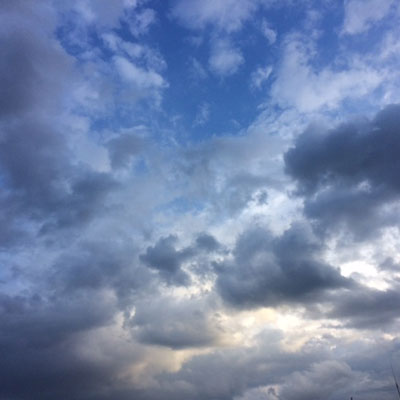
Sky over Oaxaca, September 2018
This is how the rain comes to Oaxaca.
The mid-day sun burns the skin like angry spider bites. The sky is a brilliant blue. There are no clouds. The only sound is when the doves coo.
City sounds whisper, chatter, yell, demand attention. Cars, trucks, motorcycles, ambulances, loud sirens, squeaks, car alarms, saws, hammers, sledges, motors, pumps. Locals work. Tourists wake. A truck speaker blares “El Gas!” A street vendor shouts “tamales.” A policewoman in blue uniform and black boots blows a loud whistle to organize the chaos.
A lone tuba, a snare drum, a cornet—a calenda parade—a wedding, a party, or simply the freedom to dance in the streets with the giant puppet-people.
Church bells ring erratically.
The doves coo, oblivious, focused on lovemaking.
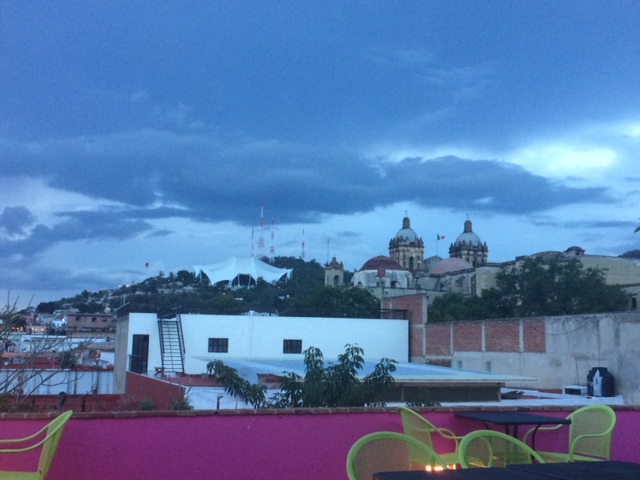
Clouds over Santo Domingo Church, Oaxaca, 2018
Unannounced and hardly noticed, large white clouds march across the sky like cauliflower soldiers. The wind arrives so slowly that it hardly seems like a wind at all. The trees rattle and swish without conviction. Somewhere a baby sings to the music of the doves.
A jet roars overhead masking the first sounds of thunder in the valley. The lightening is out there too, somewhere, disguised by the sunlight. A nonchalant complacence sets in.
The wind stops, starts again. Tree limbs sway. Swaying strings of lights and colorful banners of papel picado strung over streets and courtyards join in the fun.
Nature dances a tango bending, running forward then backward then forward again.
An eerie silence ensues.
A bird tweets its distinctive song. A self-organizing hum fills the blank spaces in the air like the crowd that arrives for a performance.
The rain doesn’t come. Not yet, but somewhere in the valley it rains, in the mountains for sure.
The leaves rustle. At last, a few solitary drops start the music.
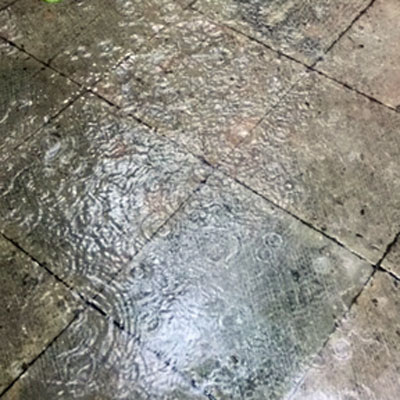
Raindrops in the courtyard of Casa de las Bugambilias, Oaxaca, 2018
Violent thunder. Deluge. There is nothing like the rain in Oaxaca. Nothing. The Zapotecas, “Be’ena’ Za’a” (the Cloud People) invite Cocijo, the god of rain, lightening and thunder. He comes as he has for centuries.
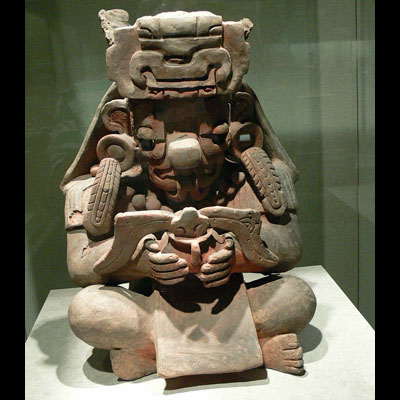
Dios Cocijo, from Monte Alban, National Museum of Anthropology, Mexico City
The sound deafens, the vision terrifies. The calenda parade blows into the sky and scatters, burning tubas flying haphazardly; mangled drums and cornets limping off in revolt, puppet-people torn to shreds. A flurry of frogs, snakes, owls, turtles, hummingbirds, all sorts of bizarre chimeras fills the air along with images of ancient Zapotec gods beautiful and frightening at once. Insects—flying ants, worms, grasshoppers, horned beetles, blood-sucking mosquitos roll, pitch and yaw like boats in a powerful storm.
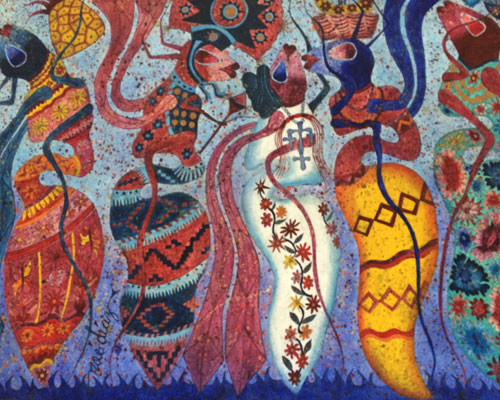
Oil painting inside Las Quince Letras restaurant, Oaxaca, Noé Díaz Ibañez artist
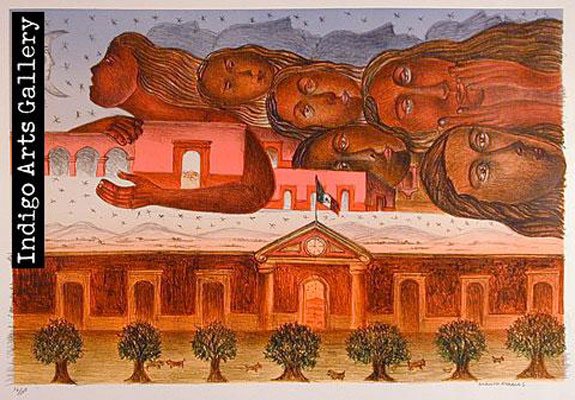
Rudolfo Morales, framed print
The water runs off rooftops, down drainpipes, into gutters, through the street. Buckets of water, a river of water, forked tongues of water, eyelids of water. Further out, beyond the clouds, the sunshine hides.
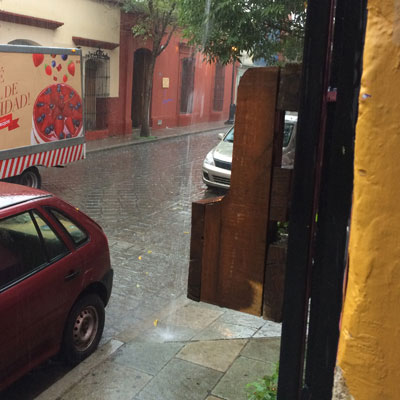
Photograph outside Tastavins, Oaxaca, 2018
The rain slows to a trickle. Someone plays a melancholy wooden flute from the shadows across the street.
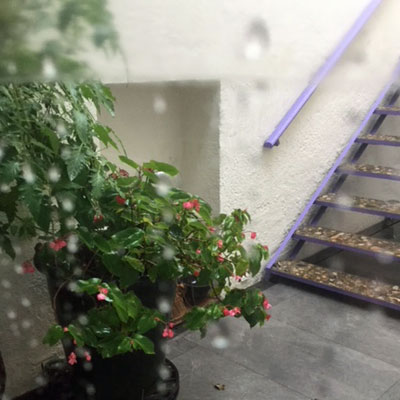
Casa de las Bugambilias, Oaxaca, 2018
Both joy and sorrow swell in the magnifying glass of the dew. We do not actually know it, but we sense it: our life has a sister vessel which plies an entirely different route. While the sun burns … Tomas Tranströmer

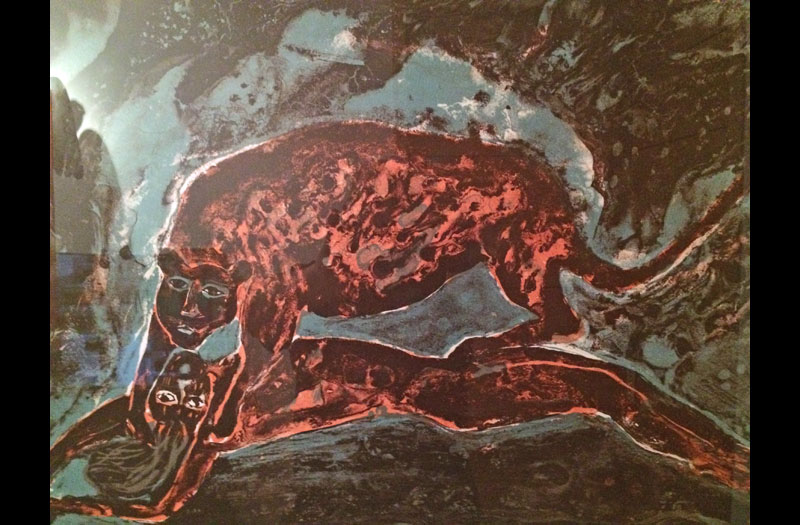
Love the painting of dancing ants — you state the artist is unknown, but isn’t that a signature “Noé Diaz” down on the left side?
Or does that mean something?
I’m enjoying your blog/journal…
Bettylou
You are absolutely correct. I don’t know how I missed the obvious but I did. His website confirms it.https://www.noediaz.com/inicio